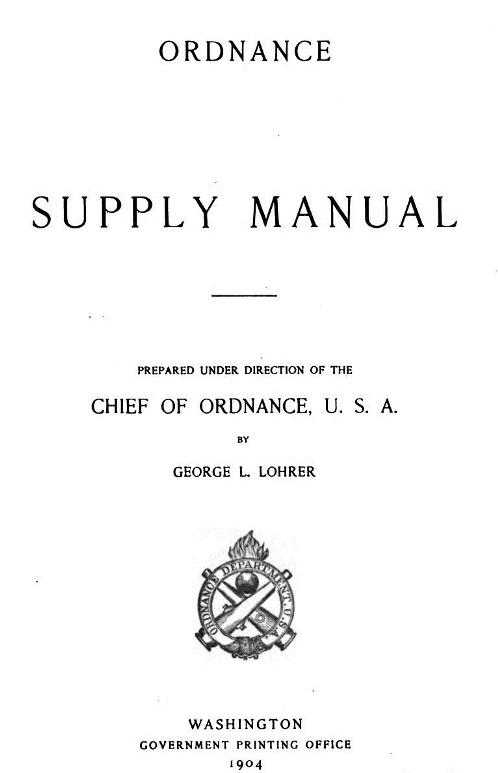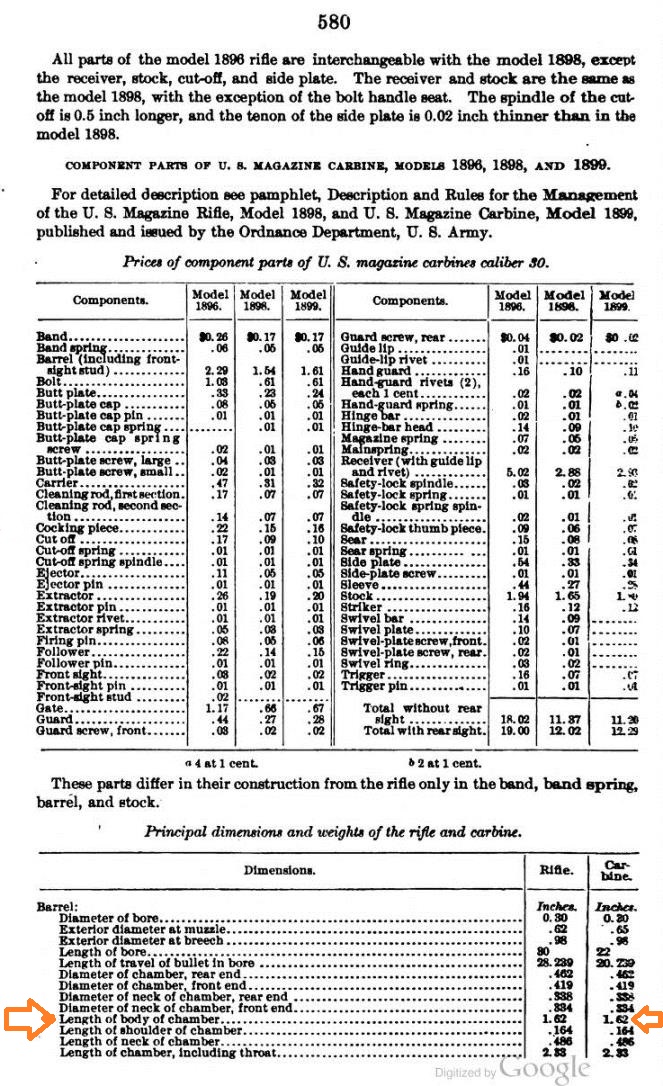Chamber differences and tough to close bolt
-
CoRifleman
- Posts: 36
- Joined: Sun Jan 19, 2020 3:28 pm
Re: Chamber differences and tough to close bolt
I love this place!
- butlersrangers
- Posts: 9944
- Joined: Wed Oct 07, 2009 11:35 pm
- Location: Below the Bridge, Michigan
Re: Chamber differences and tough to close bolt
So far, I have been unable to find documentation that the Krag barrel chamber was changed from earlier dimensions.
An Ordnance Supply publication, from 1904, lists most of the authorized changes and dates. There is no mention of a change to the chamber.
This publication gives chamber dimensions that do agree with the dimensions in the later drawing used by Mallory.


An Ordnance Supply publication, from 1904, lists most of the authorized changes and dates. There is no mention of a change to the chamber.
This publication gives chamber dimensions that do agree with the dimensions in the later drawing used by Mallory.



Re: Chamber differences and tough to close bolt
I love this place!
Yeah, no one gets mad when there are misunderstandings, we just dig a little deeper till we understand or give up. Sometimes the answers are lost in time and can not be figured out.
For BR on that drawing, could the label been mis applied by the publisher and that should have been wearing the label for pre 1899 less than 213000? I deal with some illustrations from a Swedish company catalog and the part numbers go with a different illustration that you would think. I believe they use a different labeling convention that we are used to.
Take a look at that 1.00 Radius on the outside of the barrel, have you ever seen that on any US Krag? I only have Krags with serial numbers higher than 266XXX and have not seen that profile. Do your 1896s have it? I looked at official photos on the KCA page and they all have hand guards so I could not tell if earlier barrels have that feature.
Edit:
Looked at BR's last chart again that is not the price of the change but a decimal length! Was that a temporary change to boost velocity and pressure for the 2200 fps experiment? Unlikely. Massive repeated typos? Doubt it. One would expect the latest permanent change to be the basis for SAAMI drawings. The earlier dimension became the became the basis for SAAMI? If you asked me last week I would say implausible!
We are missing something and now I have no clue what it is.
If anyone has seen that radius on the outside of any Krag barrel please raise your hand. It would be interesting but right now I am not sure what it would tell you.
-
Baltimoreed
- Posts: 368
- Joined: Fri Feb 05, 2016 11:42 pm
Re: Chamber differences and tough to close bolt
My full length resized .30-40 brass will chamber in either my school rifle or scout Krag but my segregated neck sized brass will not swap between rifles. The chambers are different enough to cause problems. My work around is to use neck sized .30-40 in the school rifle and use neck sized .303 in my scout. Neck sizing will lengthen your brasss life. I was given a bunch of .303s during the drought and figured this would be a good way to use them. I dont shoot the scout anymore though. Too many toys.
- butlersrangers
- Posts: 9944
- Joined: Wed Oct 07, 2009 11:35 pm
- Location: Below the Bridge, Michigan
Re: Chamber differences and tough to close bolt
FWIW - Before dabbling with Krags, I never expected 'fired brass' from different rifles of the same caliber to fit, almost interchangeably, without being sized.
Tolerances, wear and dimensional differences, made Full-Length Re-sizing almost a given.
It has only been with Krags that I have experienced the pleasant experience of having 'fired cases' fit in a number of rifles and carbines, without resizing.
It has not happened with all my Krags, but, does with most of them.
I have a model 1896 chamber that allows a bit more expansion in the diameter of the case body. That rifle is my sole exception, now.
(When our Krags were made, the U.S. Military was not reloading fired brass. The early Mercuric Priming had made that unwise!
Cartridges were a one shot deal and rifles just had to accept the production from Frankford Arsenal and war time contractors.
Eventually, Frankford Arsenal developed some reloading sets. It is hard to tell to what extent these were utilized. It certainly would have risked producing ammo of substandard quality.
Reloading seems to have been mainly a civilian shooter thing.
There were those reduced 'gallery practice' reloading sets, which make sense).
Tolerances, wear and dimensional differences, made Full-Length Re-sizing almost a given.
It has only been with Krags that I have experienced the pleasant experience of having 'fired cases' fit in a number of rifles and carbines, without resizing.
It has not happened with all my Krags, but, does with most of them.
I have a model 1896 chamber that allows a bit more expansion in the diameter of the case body. That rifle is my sole exception, now.
(When our Krags were made, the U.S. Military was not reloading fired brass. The early Mercuric Priming had made that unwise!
Cartridges were a one shot deal and rifles just had to accept the production from Frankford Arsenal and war time contractors.
Eventually, Frankford Arsenal developed some reloading sets. It is hard to tell to what extent these were utilized. It certainly would have risked producing ammo of substandard quality.
Reloading seems to have been mainly a civilian shooter thing.
There were those reduced 'gallery practice' reloading sets, which make sense).
